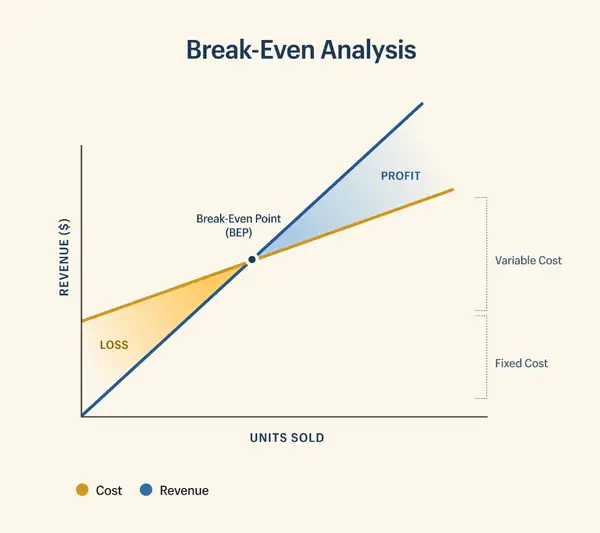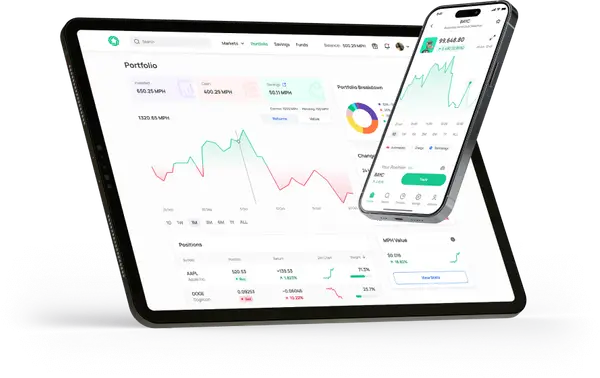An Introduction to Cost Volume Profit Analysis

In recent years, businesses have faced unprecedented challenges and changes due to the COVID-19 pandemic. The pandemic has altered cost structures, with many companies experiencing fluctuating demand and supply chain disruptions. CVP analysis has been instrumental for businesses in navigating these uncertainties. For instance, restaurants have had to adapt their operations to include delivery and takeout services, impacting their variable and fixed costs. Understanding these changes through CVP analysis has been crucial for survival and profitability.
Simply put, CVP analysis is a financial tool that examines the relationship between costs, volume, and profit. By analyzing this relationship, businesses can gain valuable insights into their breakeven point, profitability, and the impact of different factors on their financial performance. So, let's dive in and explore the world of CVP analysis!
What is Cost-Volume-Profit (CVP) Analysis?
CVP analysis, also known as break-even analysis, is a method used to determine how changes in costs and sales volume affect a company's operating profit. It involves calculating the break-even point, where total revenues equal total costs, resulting in neither profit nor loss. This analysis helps businesses understand the impact of different sales volumes on profitability.
Key Components of CVP Analysis
To understand CVP analysis, we need to familiarize ourselves with its key components:
- Fixed Costs: Fixed costs are expenses that remain constant regardless of the level of production or sales volume. Examples include rent, insurance, and salaries.
- Variable Costs: On the other hand, variable costs fluctuate based on the volume of production or sales. These costs include raw materials, direct labor, and packaging materials.
- Sales Price per Unit: The selling price of each unit of product or service.
- Contribution Margin: The difference between the sales price per unit and the variable cost per unit.
- Contribution Margin Ratio: The contribution margin ratio is a key metric in CVP analysis. It represents the proportion of each unit's sales revenue that contributes to covering fixed costs and generating profit. To calculate the contribution margin ratio, simply divide the contribution margin (sales revenue minus variable costs) by the sales revenue. A high contribution margin ratio indicates that a larger portion of each sale contributes to profitability, making it easier to cover fixed costs and generate profit.
- Break-Even Point: The break-even point is the level of sales at which a business covers all costs and transitions from a loss to a profit. It is a vital concept in CVP analysis, as it helps businesses set sales targets and make pricing decisions. By calculating the break-even point, businesses can identify the level of sales required to cover their costs and achieve profitability. This knowledge enables informed decision-making and strategic planning.

Why Use CVP Analysis?
CVP analysis is crucial for businesses because it helps in:
- Pricing Decisions: Determining the optimal price point for products or services to achieve desired profitability.
- Cost Control: Identifying areas where cost efficiency can be improved.
- Profit Planning: Setting sales targets to achieve specific profit goals.
- Decision Making: Evaluating the financial impact of business decisions, such as entering new markets or launching new products.
Conducting a Cost Volume Profit Analysis
Now that we understand the components, let's explore the process of conducting a CVP analysis.
Step 1: Calculate the Contribution Margin
Formula: Contribution Margin (CM) = Sales Price per Unit – Variable Cost per Unit
Example Calculation:
Sales price per unit: $50
Variable cost per unit: $30
CM per unit = $50 – $30 = $20
Step 2: Calculate the Contribution Margin Ratio
Formula: Contribution Margin Ratio (CMR) = Contribution Margin / Sales Price per Unit
Example Calculation:
CMR = $20 / $50 = 0.4 or 40%
Step 3: Determine the Break-Even Point
Formula: Break-Even Point (units) = Fixed Costs / Contribution Margin per Unit
Example Calculation:
Fixed costs: $10,000
Contribution margin per unit: $20
Break-Even Point (units) = $10,000 / $20 = 500 units
Formula: Break-Even Point (sales dollars) = Fixed Costs / Contribution Margin Ratio
Example Calculation:
Fixed costs: $10,000
Contribution margin ratio: 40%
Break-Even Point (sales dollars) = $10,000 / 0.4 = $25,000
Step 4: Calculate the Target Profit
Formula: Target Profit (units) = (Fixed Costs + Target Profit) / Contribution Margin per Unit
Example Calculation:
Fixed costs: $10,000
Target profit: $5,000
Contribution margin per unit: $20
Target Profit (units) = ($10,000 + $5,000) / $20 = 750 units
Step 5: Determine the Margin of Safety
Formula: Margin of Safety = Actual Sales – Break-Even Sales
Example Calculation:
Actual sales: $30,000
Break-even sales: $25,000
Margin of Safety = $30,000 – $25,000 = $5,000
Interpreting the Results of Cost Volume Profit Analysis
Once you have conducted a CVP analysis, it's crucial to interpret the results in a meaningful way.
Making Sense of the Numbers
Interpreting the results of CVP analysis requires a deep understanding of your business and industry dynamics. Analyze the breakeven point to determine the minimum sales volume required to cover costs. Pay attention to the contribution margin ratio to understand the percentage of each sale that contributes to profitability. By comparing the breakeven point with actual sales volume, you can evaluate the financial health of your business and identify potential areas for improvement.
Strategic Decisions Based on Analysis Results
The insights gained from CVP analysis can inform strategic decisions that optimize profitability. For example, businesses can identify cost reduction opportunities by analyzing the impact of changes in variable costs on the breakeven point. Pricing decisions can be made by evaluating the impact of different price levels on the contribution margin ratio and overall profitability. CVP analysis empowers businesses to make data-driven decisions backed by sound financial analysis.
Put your Cost-Volume-Profit Analysis insights into action with Morpher.com, a revolutionary trading platform tailored to maximize your strategic financial decisions. Morpher offers zero fees, infinite liquidity, and access to a wide range of asset classes, allowing you to leverage your CVP knowledge in dynamic market conditions. Whether you're interested in fractional investing, short selling, or leveraging up to 10x, Morpher's innovative blockchain-based platform is designed to elevate your trading experience. Join Morpher Today and Claim Your Free Sign-Up Bonus to revolutionize your investment approach and make the most of your financial strategies.

Potential Pitfalls in Cost Volume Profit Analysis
While CVP analysis is an incredibly useful tool, there are some potential pitfalls to be aware of.
Common Mistakes and How to Avoid Them
A common mistake in CVP analysis is assuming that all costs are fixed or variable. Businesses should carefully analyze their cost structure to accurately categorize expenses. Additionally, relying solely on historical data can lead to inaccurate results. It's crucial to regularly update your analysis to reflect changes in costs, volume, and pricing. Finally, overreliance on CVP analysis without considering broader market dynamics may limit the effectiveness of the analysis.
Limitations of Cost Volume Profit Analysis
While CVP analysis is a powerful tool, it does have some limitations. It assumes that costs and revenues are linearly related, which may not always hold true in complex business environments. Additionally, CVP analysis does not consider external factors, such as changes in market demand or the competitive landscape. Therefore, it's important to complement CVP analysis with other tools and techniques, such as market research and competitor analysis, to gain a holistic view of your business's financial performance.
FAQ: Frequently Asked Questions
What is the purpose of CVP analysis?
The purpose of CVP analysis is to help businesses understand the relationship between costs, volume, and profit. It provides valuable insights into breakeven points, profitability, and the impact of different factors on financial performance. CVP analysis enables businesses to make data-driven decisions that optimize profitability.
How is the contribution margin ratio calculated?
The contribution margin ratio is calculated by dividing the contribution margin (sales revenue minus variable costs) by the sales revenue. The resulting ratio represents the proportion of each sale that contributes to covering fixed costs and generating profit.
Why is the break-even point important?
The break-even point is important as it represents the minimum sales volume required to cover all costs and transition from a loss to a profit. It helps businesses set realistic sales targets and make informed pricing decisions.
What are the potential pitfalls of CVP analysis?
Common pitfalls in CVP analysis include inaccurately categorizing costs as fixed or variable, relying solely on historical data, and overreliance on CVP analysis without considering broader market dynamics. Complementing CVP analysis with other tools and techniques can help mitigate these pitfalls.
How can businesses utilize CVP analysis to drive strategic decisions?
CVP analysis can help businesses make strategic decisions by identifying cost reduction opportunities, evaluating the impact of different pricing levels on profitability, and informing overall business strategy. It enables businesses to make data-driven decisions based on sound financial analysis.
In conclusion, CVP analysis is a powerful tool that helps businesses understand their costs, volume, and profitability. By conducting a thorough analysis, businesses can gain valuable insights that enable them to make informed decisions, set realistic sales targets, and optimize their financial performance. So, start harnessing the power of CVP analysis and unlock the potential for growth and profitability in your business.
Ready to take your strategic financial decisions to the next level? Morpher.com offers you a revolutionary trading platform that aligns perfectly with the insights you've gained from Cost Volume Profit Analysis. With zero fees, infinite liquidity, and the ability to trade across multiple asset classes, Morpher empowers you to apply your CVP knowledge in real-time market scenarios. Whether you're looking to invest fractionally, short sell, or leverage up to 10x, Morpher's blockchain-based platform is designed to enhance your trading experience. Sign Up and Get Your Free Sign Up Bonus today to transform the way you invest and capitalize on your strategic acumen.

Disclaimer: All investments involve risk, and the past performance of a security, industry, sector, market, financial product, trading strategy, or individual’s trading does not guarantee future results or returns. Investors are fully responsible for any investment decisions they make. Such decisions should be based solely on an evaluation of their financial circumstances, investment objectives, risk tolerance, and liquidity needs. This post does not constitute investment advice.

Painless trading for everyone
Hundreds of markets all in one place - Apple, Bitcoin, Gold, Watches, NFTs, Sneakers and so much more.

Painless trading for everyone
Hundreds of markets all in one place - Apple, Bitcoin, Gold, Watches, NFTs, Sneakers and so much more.









